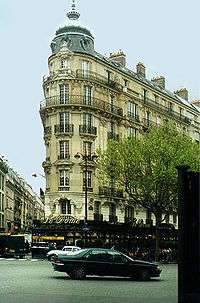Café society

Café society was the description of the "Beautiful People" and "Bright Young Things" who gathered in fashionable cafes and restaurants in New York, Paris, and London beginning in the late 19th century. Maury Henry Biddle Paul is credited with coining the phrase "cafe society" in 1915. Lucius Beebe created the term "chromium mist" for the cafe society lifestyle he chronicled in his weekly column, This New York, for the New York Herald Tribune during the 1920s and 1930s.
They attended each other's private dinners and balls, and took holidays in exotic locations or at elegant resorts. In the United States, café society came to the fore with the end of Prohibition in December 1933 and the rise of photojournalism, to describe the set of people who tended to do their entertaining semi-publicly, in restaurants and night clubs, and who would include among them movie stars and sports celebrities. Some of the American night clubs and New York City restaurants frequented by the denizens of café society included the 21 Club, El Morocco, Restaurant Larue, and the Stork Club.
See also
References
Bibliography
- Beebe, Lucius (1967). Clegg, Charles & Emrich, Duncan, eds. The Lucius Beebe Reader. Garden City, N.Y.: Doubleday & Company. OCLC 720851.
- Blumenthal, Ralph (2000). Stork Club: America's Most Famous Nightspot and the Lost World of Café Society. Boston: Little, Brown & Co. ISBN 0-316-10531-7. OCLC 42072089.
Further reading
- Young, Anthony (28 May 2015). New York Café Society: The Elite Meet to See and Be Seen, 1920s–1940s. McFarland. ISBN 978-1-4766-1906-4. OCLC 931884327.
External links
| Look up café society in Wiktionary, the free dictionary. |